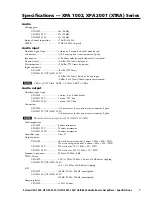
MAX9777/MAX9778
Stereo 3W Audio Power Amplifiers with
Headphone Drive and Input Mux
14
_
__
__
__
__
__
__
__
__
__
__
__
__
__
__
__
__
__
__
__
__
__
__
__
__
__
__
__
__
__
__
__
__
__
__
__
__
__
__
__
__
__
__
__
__
__
__
__
__
__
__
__
__
__
__
__
__
__
__
__
__
__
__
__
__
__
__
__
__
__
__
__
__
__
__
__
__
__
__
__
__
__
__
__
__
__
_
Digital Interface
The MAX9777 features an I
2
C/SMBus™-compatible 2-
wire serial interface consisting of a serial data line
(SDA) and a serial clock line (SCL). SDA and SCL facili-
tate bidirectional communication between the
MAX9777 and the master at clock rates up to 400kHz.
Figure 3 shows the 2-wire interface timing diagram. The
MAX9777 is a transmit/receive slave-only device, rely-
ing upon a master to generate a clock signal. The mas-
ter (typically a microcontroller) initiates data transfer on
the bus and generates SCL to permit that transfer.
A master device communicates to the MAX9777 by
transmitting the proper address followed by a com-
mand and/or data words. Each transmit sequence is
framed by a START (S) or REPEATED START (S
r
) con-
dition and a STOP (P) condition. Each word transmitted
over the bus is 8 bits long and is always followed by an
acknowledge clock pulse.
SDA and SCL are open-drain outputs requiring a pullup
resistor (500
Ω
or greater) to generate a logic-high volt-
age. Series resistors in line with SDA and SCL are option-
al. These series resistors protect the input stages of the
devices from high-voltage spikes on the bus lines, and
minimize crosstalk and undershoot of the bus signals.
Bit Transfer
One data bit is transferred during each SCL clock
cycle. The data on SDA must remain stable during the
high period of the SCL clock pulse. Changes in SDA
while SCL is high are control signals (see the
START
and STOP Conditions
section). SDA and SCL idle high
when the I
2
C bus is not busy.
START and STOP Conditions
When the serial interface is inactive, SDA and SCL idle
high. A master device initiates communication by issu-
ing a START condition. A START condition is a high-to-
low transition on SDA with SCL high. A STOP condition
is a low-to-high transition on SDA while SCL is high
(Figure 4). A START condition from the master signals
the beginning of a transmission to the MAX9777. The
master terminates transmission by issuing the STOP
condition; this frees the bus. If a REPEATED START
condition is generated instead of a STOP condition, the
bus remains active.
SCL
SDA
START
CONDITION
STOP
CONDITION
REPEATED
START
CONDITION
START
CONDITION
t
HD, STA
t
HD, STA
t
HD, STA
t
SP
t
BUF
t
SU, STO
t
LOW
t
SU, DAT
t
HD, DAT
t
HIGH
t
R
t
F
Figure 3. 2-Wire Serial-Interface Timing Diagram
SCL
SDA
S
S
r
P
Figure 4. START/STOP Conditions
SMBus is a trademark of Intel Corp.












































